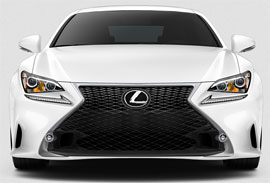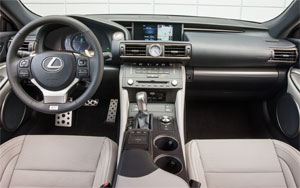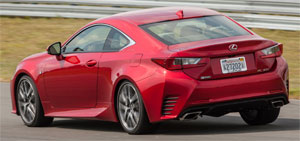2015 Lexus RC Sport Coupe
If you’ve been following the Lexus brand lately, you know that they’re on an all-out mission to shed their soft, comfy, pure luxury image…that’s still a work in progress; it takes a long time to change people’s minds about a brand. But the new RC coupe just might be the car that speeds that change along.
The 2015 Lexus RC marks the brand’s reentry into the sporty coupe segment. And from the looks of this car, they’re not jumping back in quietly. The RC may not instantly strike fear into the hearts of the German marques that dominate this segment, but they will certainly know Lexus has joined the party.
The RC’s compliant, yet very rigid chassis is an all-star for sure. It’s not a new chassis per se, but a modified combination of 2 separate Lexus platforms. The front architecture and suspension comes from the mid-size GS, while the rear comes from the compact IS, with a lot of structural bracing in between. Enough to satisfy a fairly wide variety of tastes.
Taking a walk through the lineup, things start with the RC 350. It’s the tamest model with a 3.5-liter V6 coming directly over from the GS, outputting the same 306-horsepwer and 277 lb-ft. of torque. Transmission is also the same 8-speed automatic, with steering wheel shifters, unless you choose all-wheel-drive in which case you’ll lose 2 gears.
 But, the outside is anything but tame. While it may not the most dynamic looking Lexus of all-time, it’s pretty darn close.
But, the outside is anything but tame. While it may not the most dynamic looking Lexus of all-time, it’s pretty darn close.
It’s still Lexus-smooth, but with plenty of sharp angles and body tucks to drum up some excitement. The front end screams aggression with a big-mouth grille and vertical openings slashed into the corners.
18-inch wheels are standard, with significant fender flares above them. L-shaped LED rear lighting has been updated with clear, jagged lenses protruding out. The rear bumper also gets slashed up with simulated corner vents.
Inside, things are less of a departure. There’s still lots of luxury to touch and plenty of serenity to be had when driving. Lexus calls this a pure 2+2 Coupe, so rear space, especially leg room, is limited.
4-dial gauges set a sporty tone, with a small central TFT screen providing plenty of info. 10.4 cubic-ft of space hides in the trunk, and useful folding rear seatbacks add to that. Neither back-up camera nor navigation are standard, however, but if you do upgrade, there’s a new remote touchpad for inputs.
Next up the line is the RC 350 F Sport, and the added content is very high. For the exterior, there are 19-inch wheels, unique front and rear fascia, and fender badging.
Inside it gets even better with supportive sport seats, new sport pedals, LFA-inspired gauges, black headliner, and tasteful silver trim.
 While the Sport’s engine is unchanged, there are lots of mechanical upgrades. Like adaptive variable suspension, high-friction brake pads, 4-wheel steering, and the additional Sport+ driving mode.
While the Sport’s engine is unchanged, there are lots of mechanical upgrades. Like adaptive variable suspension, high-friction brake pads, 4-wheel steering, and the additional Sport+ driving mode.
We spent most of our drive time in the F Sport and were very impressed with its light and balanced feel. Around the track at the Monticello Motor Club, things felt super-rigid with virtually no flex.
The rear-steer speeds up turn-ins, and the car has an almost Porsche-like competency, where you have a hard time believing you’re having this much fun in a straight-up street car, let alone a Lexus. And you can do some serious pushing without feeling like you’re going to end up in some “epic fail” video on You Tube.
But, where this tale really gets interesting is in the top-of-the-line RC F. This car is serious, with a 467-horsepwer 5.0-liter V8, as well as fully upgraded chassis and brakes.
It’s a beast! On the street, it feels a little nose heavy, and steering is slower, though you can dial in more with Sport and Sport+ settings, but we found it almost too aggressive for everyday use.
On the track however, it comes alive with the V8 growling on acceleration, and barking on downshifts. Transmission is also an 8-speed, but it’s different enough to get a separate internal name.
 A Torsen limited-slip rear is standard and you can upgrade to a torque vectoring rear, which includes “set-it-and-forget-it” presets for standard, slalom, and track. The torque vectoring rear is highly recommended, as it allows you to seriously late brake and perform dare-devil late turn-ins well beyond your skill set.
A Torsen limited-slip rear is standard and you can upgrade to a torque vectoring rear, which includes “set-it-and-forget-it” presets for standard, slalom, and track. The torque vectoring rear is highly recommended, as it allows you to seriously late brake and perform dare-devil late turn-ins well beyond your skill set.
All of that, along with huge 6-piston Brembos up front, make the RC F a legit player in the RS, M, and AMG game. Lexus claims 0-60 happens in 4.4-seconds and we believe it.
Prices are competitive too, starting at $43,715 for the RC 350, the F Sport comes in at $47,700, and the big-dog RC F goes for $63,325.
While the LFA got the performance-image ball rolling for Lexus, things have been slow in gaining momentum. But we think the 2015 RC is a game changer, and just what the Lexus makeover has been waiting for.
Specifications
- Engine: 3.5 liter V6
- Horsepower: 306
- Torque: 277 lb-ft.
2025 Infiniti QX80
Infiniti’s Flagship SUV Sets A Course For Extravagance
This full-size Infiniti QX80 started out as the QX56, a hastily rebadged version of Nissan’s truck-based Armada full-size utility. That was in the early 2000s when the luxury SUV craze was exploding. It wasn’t as much as a game-changer, as it was “try to keep upper”. Now, this new QX80, Infiniti is promising to “Reimagine the luxury SUV”. Let’s see if Infiniti has turned their imaginations into reality.
Well, if over the top is what Infiniti was shooting for in the all-new 2025 QX80, mission accomplished. There’s an overall feeling of extravagance here that we haven’t experienced from Infiniti in quite some time.
It’s not just the open pore ash wood trim with aluminum inlays, 24-speaker audio, and plush quilted leather seating; there’s also nicely integrated ambient lighting, a massive glass roof, plenty of tech, lots of active driving assistance, and even chilled center console storage. Forward of that is a dual touchscreen setup; the top 14.3-inch touchscreen for infotainment sits next to the digital gauge display in a single housing; while just below, there’s a 9-inch one for climate controls.
You are reminded this is still a body-on-frame utility the moment you have to climb up into the cockpit, but there’s also the commanding view of the road that comes with that. Captain’s chairs are standard for the second row, but a three-place bench is optional with all trims except for top Autograph which comes exclusively with these climate-controlled massaging chairs, along with a touchscreen control panel. The third-row experience is great, too, with heated leather seating, and adult size room for three.
Now, there is a whole new experience coming from under the hood. The last gen’s V8 has been replaced with a new twin-turbo 3.5-liter V6 rated at 450 horsepower, 50 over the V8. More notably, torque is up by more than 100 lb-ft to 516. Transmission is a nine-speed automatic, two more gears than last year, with rear-wheel drive standard, four-wheel drive an option. Max tow rating is 8,500-lbs.
And at the test track, it did pull strongly off the line, getting up to speed in a hurry with the 0-60 sprint taking just 6.3 seconds. There is roughly 3 tons of weight to push through the quarter-mile, but that twin-turbo does it well, finishing in 14.7 seconds at 95 mph. Gear changes are incredibly smooth, while not hindering acceleration in any way.
It's an impressive looking utility from any angle.
In panic braking runs, there was some fade and a considerable amount of nosedive, but our average stopping distance of 115 feet is not bad for a vehicle as big and heavy as the QX80. Last gen, the QX80 moved from the Titan truck platform to the global Patrol SUV chassis, which shifted the vibe from budget Escalade to Lexus LX fighter. The attending improvement in ride and handling was the real bonus, and that largely continues for this gen with air suspension and Dynamic Digital Dampers on all but base QX80s. While we could certainly feel all that weight through our cone course, body roll was well-controlled and without significant oversteer or understeer.
It’s an impressive looking utility from any angle, starting right up front with the big “bamboo forest” grille. The overall shape is boxy, but all body panels are smooth; and for better or worse, Infiniti joins the flush door handle fad. Look for its “Artistry In Motion” design theme to work its way down through the rest of the Infiniti lineup. All QX80s ride on 22-inch wheels except for base Pure trim which makes do with 20s.
A full power play includes standard motion-activated rear liftgate and power operation of both second and third row seats, expanding cargo capacity from 22 cu-ft behind the third row to 59 behind the second, and a max of 101.0 cu-ft with both rows folded.
Government Fuel Economy Ratings with four-wheel-drive are not great: 16 city, 19 highway and 17 combined. We averaged 18.6 mpg of premium. That’s a much worse than average Energy Impact Score, using 17.5 barrels of oil annually, with 8.6 tons of CO2 emissions.
Driving such a PUREly LUXEurious SENSORY overload, you’ll probably be expecting people to want your AUTOGRAPH, which we’re guessing is how Infiniti came up with their grade structure; pricing starts with Pure at $84,445 and climbs to $112,590 for Autograph.
The 2025 Infiniti QX80 is a massive SUV that delivers massive amounts of power and luxury. They aimed for the moon here and have clearly blasted themselves into a much more competitive orbit in the big buck, big hauler, sport-utility galaxy.
Specifications
As Tested
- Engine: 3.5-liter twin-turbo V6
- Transmission: 9-speed automatic
- Horsepower: 450
- Torque: 516 lb-ft.
- EPA: 16 City | 19 Highway | 17 Combined
- 0-60 mph: 6.3 seconds
- 1/4 Mile: 14.7 seconds at 95 mph
- Braking, 60-0 (avg.): 115 feet
- MW Fuel Economy: 18.6 mpg (Premium)
























































